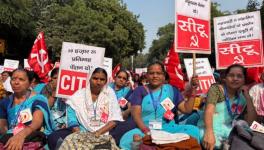India faces big challenges in its efforts towards ratification of conventions relating to OSH. The first progressive step that it could take in this direction is to endorse the FPRW, which includes “a safe and healthy working environment” as another fundamental principle.
——-
The International Labour Organisation (‘ILO’) adopted in 1998, the Fundamental Principles and Rights at Work (‘FPRW’) riding on the strength of two premises, among others: that the extension of the fundamental rights would enable the persons in the economic system to claim freely and on the basis of equality of opportunity their fair share of the wealth, and that ILO is the undisputed global organization competent and legitimate to design and promote fundamental principles and labour standards.
The FPRW declared that even if the member countries have not ratified the said convention(s), they “have an obligation, arising from the very fact of membership in the Organization, to respect, to promote and to realize, in good faith and in accordance with the Constitution, the principles concerning the fundamental rights…”
The FPRW outlines four fundamental principles, viz. (a) the freedom of association (‘FOA’) and the effective recognition of the right to collective bargaining (‘CB’), (b) the elimination of all forms of forced or compulsory labour, (c) the effective abolition of child labour, and (d) the elimination of discrimination in respect of employment and occupation.
One may wonder as to the exclusion of labour rights like the right to safe workplace (right to life) to enable earnings capacity throughout the workers’ lives, and to minimum wages, below which any wage would constitute ‘exploitative wage’, among others. Of course, there were two grounds for their non-inclusion then. One, the four labour rights that were selected did not impose any direct monetary liabilities to the nations ratifying them. Countries differ in terms of their stages in economic development and standards like occupational safety and health (‘OSH’), and minimum wages could not be brought under the FPRW framework, for they would have differential, if not difficult, economic outcomes for less developed and poor countries.
Second, there is no disagreement amongst any country that forced labour is not permissible. On the other hand, though in agreement in principle with respect to elimination of child labour, poor countries justified the same on grounds of economic poverty. Freedom of association and collective bargaining are two collective labour institutions that provide basis for social dialogue, both at the micro and macro levels, which could eventually result in better division of income and wealth. In a collective sense, the four labour standards “enable” achievement of decent work. To be sure, the FPRW declaration emphasized that the eight labour standards must not be used for protectionist purposes.
At the same time the identification of handful conventions as core conventions, ILO has created a hierarchy of its own labour standards. It is significant that they core ILO conventions did not include conventions on minimum wages, social security or conditions of work. Thus the FPRW segmented the rights into universal and core labour rights, and “others” – the othering of rights included very basic issues concerning the world of work like OSH and minimum wages, among others.
In a critical sense, it also implicitly under-valued the informal economy as freedom of association and the right to collective bargaining in a large sense relate to the small formal economy in the vast majority of poor and developing countries – in India, the best estimate of union coverage may not be more than 15 per cent of the total workforce, and if non-agricultural and non-governmental sector is concerned, then it would be somewhere between 25 and 30 per cent.
Moreover, the governments of the developing countries, especially in the Asia and Pacific region, are reluctant to ratify them chiefly on political grounds. As a result, more than 40 per cent of the world’s population lives in countries that have not ratified either freedom of association or collective bargaining ILO Conventions.
Even though the FPRW was a valiant statement of reaffirming a set of labour rights as core and undeniable human rights, there existed cracks within the FPRW for reasons stated above.
Trade unions around the world were animated that OSH is not regarded as a core labour right. The COVID-19 pandemic imposed incalculable loss of lives and businesses together across the world. Various estimates showed that human life at work is at great danger and a risk.
Several global OSH bodies like The Institution of Occupational Safety and Health strongly backed the International Trade Union Council’s (‘ITUC’) call for inclusion of OSH as a part of fundamental rights. ITUC General Secretary, Sharan Burrow, observed:
“Some 2.3 million people die each year due to workplace illness and accidents and the current pandemic will only add to this appalling loss of human life. Many millions more have been injured or have long-term illnesses from their work.
“The right to protection from deadly work processes, noxious chemicals and other hazards must be recognised as a fundamental right, along with freedom of association and collective bargaining and protection from discrimination, forced labour and child labour. These are all cornerstones of the new social contract the world so desperately needs to build resilience and recovery in the COVID-19 era.”
Though the International Organization of Employers recognized the value of OSH, it did not want to elevate it to a fundamental right alongside FOA and CB. It argued that OSH is frequently the result of irresponsible behaviour of workers, and that OSH could be addressed in ways other than making a fundamental right.
On March 23, the ILO’s Governing Body, a tripartite committee “overwhelmingly supported a call from worker members to move ahead with the process to designate occupational health and safety an ILO Fundamental Right at Work (FRAW)”. This was expected to be discussed in the International Labour Conference (‘ILC’) to be held in June 2022. ITUC’s arguments are fundamental, and are well captured by the punch-line: “We need to put people before profit…”
Also read: Inspecting industrial safety – A case for enhanced state oversight in Gujarat
In the plenary session of the ILC held on June 10, the delegates adopted a resolution to add the principle of “a safe and healthy working environment” to the ILO’s FPRW 1998. As is customary, two ILO Conventions concerning OSH have been added to the ILO’s Core Conventions, viz. Occupational Safety and Health Convention, 1981 (No. 155) , and the Promotional Framework for Occupational Safety and Health Convention, 2006 (No. 187).
One may wonder as to the exclusion of labour rights like the right to safe workplace (right to life) to enable earnings capacity throughout the workers’ lives, and to minimum wages, below which any wage would constitute ‘exploitative wage’.
As the Resolution itself notes, it is one thing to pass a fundamental principle; it is another to implement it across the globe. It requires the active participation of governments, employers and workers through a system of defined rights, responsibilities and duties, as well as through social dialogue and cooperation. This is particularly so given that OSH Core Conventions C.155 and C.187 have a poor ratification record as on date.
Ratification of Core Conventions relating to OSH (as on July 14, 2022)
| Region | OSH | |
| C.155 | C.187 | |
| Total (187) | 74 | 56 |
| Africa (54) | 22 | 14 |
| Americas (35) | 12 | 6 |
| Arab States (11) | 2 | 1 |
| Asia and the Pacific (36) | 8 | 7 |
| Europe (51) | 30 | 28 |
Source: ILO
Just 74 and 56 of the 187 countries have ratified OSH Core conventions, C.155 and C.187 respectively. Even Europe is lagging behind, with a poor ratification record of just over 50 per cent (58.82 per cent for C.155 and 54.90 per cent for C.187), though it is much ahead of other regions.
C.155 and C.187: A brief summary
It would be helpful to know the basic elements of the two core conventions on OSH.
C.155 applies to all branches of economic activity in which workers, that is, all employed persons including public employees, are employed, including public services, and to all workers therein. The term “workplace” covers all places where workers need to be at or to go by reason of their work, and which are under the direct or indirect control of the employer.
All member countries in consonance with the conditions prevalent in them formulate, implement and review periodically a national policy on OSH. The aim of the policy “shall be to prevent accidents and injury to health arising out of, linked with or occurring in the course of work, by minimising, so far as is reasonably practicable, the causes of hazards inherent in the working environment.” There must be in place regulations or laws to implement the national policy. It must be accompanied by an adequate enforcement machinery which can inflict penalties on erring employers. There must exist a database of occupational accidents and diseases. The Convention stresses tripartite consultations at all levels and for various matters.
According to C.187, there must be in place a national policy and a national system for occupational safety and health, a national programme on occupational safety and health, and a national preventative safety and health culture.
Also read: In pursuit of labour market dreams: Need for new and pragmatic thinking
OSH and India
ILO notes that more than 40 standards deal specifically with OSH and “nearly half of ILO instruments” deal directly or indirectly with OSH issues. However, it identifies key instruments, which we note here. They are divided into three aspects:
(1) Key instruments on OSH, viz. Promotional Framework for OSH Convention, 2006 (C.187), OSH Convention, 1981 (C.155), and Occupational Health services Convention, 1985 (C.161);
(2) Health and Safety in particular branches of economic activity, viz. Hygiene (Commerce and Offices) Convention, 1964 (C.120), Occupational Safety and Health (Dock Work) Convention, 1979 (C.152), Safety and Health in Construction Convention, 1988 (C.167), Safety and Health in Mines Convention, 1995 (C.176), and Safety and Health in Agriculture Convention, 2001 (C.184);
(3) Protection against specific risks, viz. Radiation Protection Convention, 1960, (C.115), Occupational Cancer Convention, 1974 (C.139), Working Environment (Air Pollution, Noise and Vibration) Convention), 1977 (C.148), Asbestos Convention, 1986 (C.162), and Chemicals Convention, 1990 (C.170).
As on July 14, India has ratified only 47 Conventions and one Protocol. India has ratified several conventions which are somehow related to OSH, that is, hours of work, accidents, occupational diseases, and so on. However, it has ratified only one of the Conventions noted above, which is, C.115 – Radiation Protection Convention, 1960 (No. 115) in 1975.
In the plenary session of the ILC held on June 10, the delegates adopted a resolution to add the principle of “a safe and healthy working environment” to the ILO’s FPRW 1998.
Article 39(e) of the Constitution directs the State to ensure “that the health and strength of workers, men and women, and the tender age of children are not abused and that citizens are not forced by economic necessity to enter avocations unsuited to their age or strength;” further, as per Article 42, the State “shall make provision for securing just and humane conditions of work and for maternity relief.”.
India possibly thought of progressing towards ratifying OSH Convention C.155. As a prelude to it, as is normal, India issued a National Policy on Safety, Health and Environment at Workplace. The Policy states that the “[g]overnment is committed to regulate all economic activities for management of safety and health risks at workplaces and to provide measures so as to ensure safe and health working conditions…” It recognizes the role of OSH’s contribution towards productivity, growth and overall welfare of people. It identifies the role of some factors like changing job patterns and sub-contracting in posing problems in managing OSH. It also recognizes the role of technology in mitigating hazards, but also creating new risks. The Policy, in short, makes the right signals, including stressing the need for an adequate and effective labour inspection system.
Where do we stand with respect to OSH?
Where do we stand in respect of laws and regulations, and the enforcement system regarding OSH? We have labour laws covering certain primary economic activities like factories, ports and docks, mines, plantations, construction, among others. There exist elaborate measures to ensure workers’ safety and health in them. Even the newly framed Code on Occupational Safety and Health and Working Conditions, 2020 merely put together the laws for various sectors like factories, mines, plantations, construction, and so on. This is the gravest shortcoming of the so-called codification of labour laws.
While the Code introduces some new provisions relating to OSH, it dilutes the existing ones. For example, earlier, under the Factories Act, 1948, every factory carrying out hazardous processes or a hazardous factory had to have in place a bi-partite Safety Committee. Now, the constitution of the Safety Committee has been left to the executive process of “government notification”. Further, Safety Officers are required to be appointed only in factories or mines or plantations employing a certain number of workers. Both of these clauses seriously dilute OSH.
The Directorate General, Factory Advice Service and Labour Institutes (‘DGFASLI’) deal with safety and health of workers employed in factories and ports. The Director General of Mines and Safety is concerned with the safety and health of mining workers. There is no agency nor any other labour law to cover the workers in the unorganized workers, and those working in the micro, small and medium establishments.
The National Policy on Safety, Health and Environment at Workplace recognizes the role of OSH’s contribution towards productivity, growth and overall welfare of people. It identifies the role of some factors like changing job patterns and sub-contracting in posing problems in managing OSH. It also recognizes the role of technology in mitigating hazards, but also creating new risks.
It is pertinent to note that the National Commission on Enterprises in the Unorganised Sector (‘NCEUS’) submitted a detailed report on the conditions of work in the unorganized sector, viz. Report on Conditions of Work and Promotion of Livelihoods in the Unorganised Sector. The present National Democratic Alliance (‘NDA’)-run Union Government has studiously avoided referring to any of the excellently analytical reports of NCEUS in its drive to introduce labour law reforms, and solely relied on the Report of the Second Commission on Labour constituted by the then NDA government.
Also read: Delay and complexities plague labour reforms
A global survey on occupational health services in 2017 reported that “India had one OHP/66581 workers in the total labour force, and some African countries had one OHP/1–4.5 million employees.” In 2014, China, India and Brazil, together employed a total of 68 per cent of the workers of the surveyed worker population. Coverage was 26 per cent in Brazil, 10 per cent in China, and below 10 per cent in India. In fact, if we deduct informal work in the formal sector and exclude some segments of the services sector like trade and restaurants, then the coverage in India would be around 6-7 per cent.
There is no direct law to regulate OSH in agriculture as there are in other branches of economic activity. The Shops and Commercial Establishments Act, which is a state legislation, covers much of the services sectors and those factories not covered by the Factories Act. However, this act makes a passing reference requiring the employers to “safeguard health, safety and welfare of the employees while on duty;” It does not talk of industrial accidents. (For instance, see the Punjab Shops and Commercial Establishments Act, 1958).
The statistical system that exists in India provides unreliable and often incomplete statistics on industrial relations relating to industrial accidents. The statistical system conceived during the early years of the planned economy continues even now.
For example, the Indian Labour Statistics (an annual flagship publication of the Labour Bureau) publishes data on industrial accidents relating to four sectors: factories, mines, ports, and railways. Over so many decades, no more sector has been added. Construction is the glaring omission. Over the years, many major state governments do not submit annual returns in time or fail to submit them, and hence Labour Bureau publishes extremely incomplete data. Even the data published could have been visualized better to provide a complete picture of industrial injuries in India. The Labour Bureau does not publish any statistics on occupational injuries. Thus, there exists a serious data deficit in India relating to OSH.
India has not ratified C.155 primarily because OSH in two of the largest employing sectors, namely agriculture and the micro, small and medium sectors, are not regulated by any law. According to a report on OSH in India prepared by DGFASLI and ILO:
“The agriculture sector is lacking on legislation on safety and health for the workers working in this sector. There are certain Acts on occupational safety and health pertaining to certain equipments or substances, viz., the Dangerous Machines Regulation Act, the Insecticides Act. The enforcement authorities are not identified under these Acts and hence are not being enforced. The agriculture sector is the largest sector of economic activity and needs to be regulated for safety and health aspects. Lack of legislation on safety and health in the agriculture sector is hindering the ratification of ILO convention 155. Industries under MSME do not have any legislation to cover the safety and health of the workers.”
The present NDA-run Union Government has studiously avoided referring to any of the excellently analytical reports of NCEUS in its drive to introduce labour law reforms, and solely relied on the Report of the Second Commission on Labour constituted by the then NDA government.
So, it is going to be a tough ask for India to proceed in the direction of ratifying ILO Core Conventions, C.155 and C.187. Employers see OSH as a cost while actually expenses on OSH could be seen as an investment. A safe and healthy workplace prevents accidents and occupational diseases, reduces, if not prevents, industrial accidents, especially fatal ones, thus ensuring higher participation of workers in economic activity, improves productivity, and thereby, in an overall sense, boosts economic efficiency, which eventually means higher economic growth.
Also read: Report on worker safety in Indian auto sector presents a despairing state of affairs
There is a much simpler reason which the ITUC put: human lives matter more than corporate profits. India faces large challenges in its efforts towards ratification of conventions relating to OSH. The first progressive step that it could take in this direction is to endorse the FPRW which includes “a safe and healthy working environment” as another fundamental principle. Trade unions, academics, and more importantly, the industry bodies must lobby with the government towards these measures.
While countries across the world will be grappling with efforts to endorse the revised FPRW and ratify Core conventions relating to OSH, efforts must begin in framing a case for including minimum wages and social security (in consonance with the level of economic development of the member countries) among the fundamental principles. Minimum wages deserve as much attention as others in FPRW.
In fact, the Second National Commission on Labour (2002) suggestively remarked that social security should be elevated to the pedestal of a fundamental right. India has not ratified the ILO Social Security (Minimum Standards) Convention, 1952 (C.102). So, the labour agenda is never finished. The walk is longer and strenuous as neoliberal globalization is more likely to put obstacles to the realization of rights as fundamental principles. It would indeed be a challenge, but trade unions have battled for long for various rights, acquired and denied, as well as new ones.
Dr. K R Shyam Sundar is Professor, HRM Area, XLRI, Xavier School of Management, Jamshedpur.

























